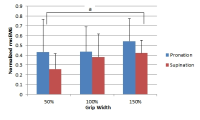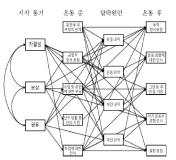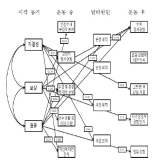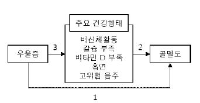PURPOSE The purpose of this study was to compare the dynamic postural control of youth athletes with and without a history of lateral ankle sprains. METHODS Twenty-eight youth athletes (14 lateral ankle sprain, 14 healthy control) participated in this study. All participants answered the Foot and Ankle Ability Measure questionnaire and were subject to the Star Excursion Balance Test (SEBT) for dynamic postural control evaluation to collect the joint angles of the lower extremity, a center of pressure (COP) path, and COP velocity. Independent sample t-test or Mann-Whitney U-test were performed to analyze the difference between the groups. RESULTS The lateral ankle sprain group (LAS) was found to have a long experience in participating in sports, and low Foot and Ankle Ability Measure scores were identified when compared to the healthy control (CON; p<0.05). LAS was observed with a short reach distance, less hip flexion, and dorsiflexion angles during the anterior direction of SEBT when compared to CON (p<0.05). Furthermore, LAS showed a slower anteroposterior and mediolateral center of pressure velocities in the posteromedial aspect of SEBT and a slower anteroposterior COP velocity in the posterolateral aspect of SEBT when compared to that of CON (p<0.05). There were no differences between the groups with respect to the other variables (p>0.05). CONCLUSIONS Based on these results, decreased anterior reach distance of SEBT may be affected by changing the dynamic posture control strategy of the lower extremity joint on the sagittal plane in LAS.

Purpose The purpose of this study is to investigate the effects of grip width and hand orientation on muscle activities of upper body during the lat pull-down. Methods Eight healthy men performed the 6 grip variations (3 grip width × 2 hand orientation) using an experimentally determined load of 70% of 1 repetition maximum. Five trials were analyzed for each grip type. Participants maintained a cadence of 2-second concentric and 2-second eccentric phases. The grip widths were normalized for each individual by using their biacromial diameter (100%), and then set the grip width 50% of biacromial diameter and 150% of biacromial diameter. Surface EMG of the latissimus dorsi, pectoralis major, infraspinatus, biceps brachii, triceps brachii, rectus abdominis, erector spinae and middle trapezius was recorded, and the root mean square of the EMG was normalized, using a maximum isometric voluntary contraction. Results Latissimus dorsi showed higher muscle activities in 100% grip width than those of 50% grip width. Pectoralis major and rectus abdominis showed higher muscle activities in 50% and 100% grip width than those of 150% grip width. Middle trapezius showed higher muscle activities in 150% grip width than those of 50% grip width. Conclusions Two-way repeated measures ANOVA for each muscle revealed that latissimus dorsi and middle trapezius (the posterior muscles of trunk) showed higher muscle activities in wide grip, on the other hand, pectoralis major and rectus abdominis (the posterior muscles of trunk) showed higher muscle activities in narrow grip.






PURPOSE This study analyzed the effect of dynamic lumbar kyphosis on the biomechnical factors affecting the lumbar joints during deep squats. METHODS Thirty adults in their 20s who had experienced weight training for more than one year participated in this study (age: 23.4±3.5years old, height: 175.3±4.3cm, weight: 75.8±6.5kg, squat single repetition maximum (1RM) weight: 115.3±19.5kg). Under both restricted dynamic lumbar kyphosis (RDLK) and dynamic lumbar kyphosis (DLK), subjects completed one repetition of deep squats at a load of 70% of their 1-RM weight. To verify the consistency of deep squat movements performed under DLK and RDLK conditions, intra-rater reliability was analyzed using intra-class correlation . The biomechnical variables of the lumbar joint were calculated during DLK and RDLK deep squats. Paired sample t-tests (IBM SPSS 27.0, Armonk, New York, USA) were used for statistical verification. RESULTS During the deep squat movement performed in DLK and RDLK conditions, the peak angles of the ankle, knee, and hip joints, the minimum height of the pelvis, and the time and tempo showed statistically high reliability, confirming the accuracy of the movement. The peak flexion angle and moment, left flexion moment, left rotation moment, and compression force factors of the lumbar joint during deep squat were significantly lower in RDLK than in DLK. CONCLUSIONS Restricting lumbar dynamic kyphosis during deep squats is essential for decreasing the risk of lumbar joint injury.
Purpose This study was designed to examine the effects of a single corrective exercise (CEX) and corrective kinesio taping (CKT) on gait patterns, plantar pressure, balance, and pain in 20~30s female patients with moderate hallux valgus. Methods Twenty-one participants (age: 30.1±5.1 yrs; height: 164.1±4.8 cm; body weight: 56.7±6.8 kg; body mass index: 21.2±5.7 kg·m-2; hallux valgus angle: 27.2±6.1°) with hallux valgus was recruited and participated in three trials, i.e., CEX trial, CKT trial, and combined CEX and CKT (CEX+CKT) trial, repeatedly in a counter-balanced order. One week of wash-out period was placed between the trials to minimize the effect of the previous treatment on the next treatment. Variables related to gait pattern, plantar pressure, balance, and pain were measured during each treatment. We carried out repeated two way ANOVA on measured variables. Results 1) Regarding gait patterns, CEX treatment and CEX+CKT treatments showed significant increases in the length of patients strides, the single support line during the stance phase, and significant reduction of the cadence. 2) Regarding gait cycle, CEX treatment and CEX+CKT treatments showed significant reductions in the contact times of forefoot, midfoot, and heel. There was a significant reduction of double stance phase in CEX treatment. 3) Regarding foot pressure on gait, CEX+CKT treatments significantly increased the maximum pressure of midfoot and heel. CEX treatments significantly increased the maximum pressure of forefoot. 4) Regarding balance, CEX treatment and CKT treatments significantly increased one leg standing with eyes closed. 5) Pain was significantly reduced in CKT treatment and CEX+CKT treatments. Conclusions According to the aforementioned results, it was concluded that a single CKT treatment was effective in reducing pain when walking and that plantar pressure, gait pattern, gait cycle, and balance were improved through a single bout of CEX treatments. Therefore, treatments by stage, starting with CKT treatments to reduce the pain, and then treating CEX to improve the gait pattern, gait cycle, foot pressure when walking, and balance ability, would be effective. Future research is warranted to identify the effects of long-term treatments.
PURPOSE The purpose of this study was to investigate the applicability of proprioceptive-dependent training as an effective physical training method by analyzing the effects of proprioceptive-dependent training on the accuracy of perceived and actual distance as well as the correlation between the changes in the two variables. METHODS Thirty-six male college students took part in the experiment. Participants were beginners with no previous experience in golf or less than five times of experience. They were randomly assigned to one of three groups; proprioceptive-dependent training, visual-dependent training, and control, maintaining the same sample size per group. The experiment was carried out in the order of pre-test, practice section, and post-test. In the pre-test, putting was tested to assess the accuracy of perceptual and actual distance in the 1-15m distance in a random order using a digital putting analyzer. In the practice section, proprioceptive-dependent and visual-dependent training groups practiced a total of 90 putting, six times per distance with the eyes closed or open. The post-test was the same as the pre-test. The accuracy of perceived and actual distance and the correlation between the changes in the two variables were analyzed using the calculated absolute errors. RESULTS The results of this study showed that there was no difference between groups in pre-test. In contrast, in post-test, the absolute error was significantly decreased in the order of proprioceptive-dependent training, visual-dependent training, and control group in the three distance conditions. Besides, for the proprioceptive-dependent training group and visual-dependent training group, there was a significant positive correlation between the changes in the accuracy of perceived and actual distance. CONCLUSIONS These results provide insight into the applicability of proprioceptive-dependent training for enhancing motor performance by showing the effects of proprioceptive-dependent training on perceived distance, actual distance, and the correlation between the two variables.

The purpose of this study is to explore the drop-out process of student-athletes and propose valuable policy ideas related to interscholastic sports. For this purpose, we surveyed 560 middle and high school drop-out student athlete's in 13 areas and finally 400 completed surveys were used for the study. To set the scales used for the study and test the reliability and validity of the scales, factor-analyses, Cronbach's alpha, and interfactor correlations were conducted using SPSS. For the main test, the paths analyses were carried out with AMOS program. As a result, we found two paths which had major effects on the drop-out process of student-athletes, self-efficacy path at the point of starting athletic career and negative relation path during athletic experiences. Based on these results, the following policy ideas were proposed. First, student-athletes should be able to join and leave athletic teams voluntarily. Second, the comfortable environments were provided to promote student-athletes' positive emotion toward athletic teams.







The purpose of this study was to investigate the relationship between depression and bone mineral density in Korean elder men (55+), and test mediating role of health behaviors. Korean National Health and Nutrition Examination Survey 2006-2011 data were analyzed. Bone mineral density was measured using DXA. Depression was measured by whether a participant had diagnosed depression, depressed mood lasted longer than 2 weeks, and/or suicidal thinking. Mediating health behaviors were serum vitamine D, calcium intake, high-risk drinking, endurance physical actiity, and resistance exercise. The associations among depression, health behaviors, and bone mineral density with demographic covariates were tested by linear regression, logistic regression, and path analysis. Diagnosed depression was not significantly associated with bone mineral density. Men who experienced substantial depressed mood and suicidal thinking has significantly lower bone mineral density than non-experienced counterparts. The effect of suicidal thinking on bone mineral density was mediated by endurance physical activity only. This study results suggest that elder men who experienced severely depressed mood and suicidal thinking were at-risk population for osteopenia. Also, physical activity intervention seems to be a priority to prevent osteoporosis comorbidity in depressed people.


PURPOSE This study examined the effects of focus of attention on beginning golfers’ competitive anxiety and motor performance. METHODS Forty-eight college students with no prior golf putting experience were selected as participants and randomly assigned to internal-focus, external-focus, holistic-focus, and control groups (12 participants each). All subjects performed 5-m golf putting in acquisition, noncompetitive, and competitive situations. RESULTS In competitive situations, the internal-focus, holistic-focus, and control groups showed golf putting accuracy and consistency similar to those in noncompetitive situations, whereas the external-focus group’s golf putting accuracy and consistency were significantly lower in competitive situations than in noncompetitive situations. In addition, the holistic-focus group showed significantly higher golf putting accuracy than the control group in both competitive and noncompetitive situations. CONCLUSIONS Holistic-focus can be used effectively as a strategy for beginners to learn motor skills and reproduce learned motor skills when state anxiety increases. However, external attention focus cannot be considered a strategy to induce effective beginners’ exercise performance when competitive state anxiety increases.
Purpose The purpose of this study is to investigate the factors for setting proper training duration of frequency that can guarantee the student athletes' right to study and performance, and to derive the ranks of setting proper training duration of frequency of student athletes by school level. Consequently, to provide basic data for the development of training guidelines for the growth period of Korean student athletes. Methods Delphi and Analytic Hierarchical Process(AHP) techniques were used. The Delphi survey was conducted in three phases, and collected data through Delphi survey were computed by SPSS win ver. 22.0 and Excel, using the mean, standard deviation, median, and coefficient of variation. Using the AHP technique, we classified the factors for setting proper training duration of frequency derived through Delphi survey, and calculated the importance by using Microsoft Excel 2010. Conclusion First, elementary students should be guaranteed regular class participation, have basic after school training, and be provided with adequate rest so that they do not lose interest in the exercise. Second, middle school students are required to decide whether to continue exercise based on their ability to exercise and abundant experience. Therefore, when abandoning the exercise, students should be able to faithfully carry out their academic performance. Third, high school students are directly related to college entrance and employment, so they have to concentrate on performance rather than on academic performance.

Purpose: This study was to verify the relationship between coaching behavior(autonomy/controlling behavior), self-regulation motivation and performance. Method: 356 athletes (from middle to work and professional team) in individual and team sport completed coaching behavior scale developed by this researchers assessing autonomy and controlling coaching behavior perceived by players, Korea Basic Pyshoclogical Needs Scale (KBPNS) assessing basic psychological needs, Behavioral Regulation in Sport Questionnaire (BRSQ) assessing sports motivation level based on self-determination theory, and sport performance score. To estimate the relationship between coaching behavior, self-regulation motivation and performance, this study employed the structure equation modeling analysis. Results: The relationship between psychological needs, regulation motivation and performance showed that autonomy coaching behavior tend to reinforce competence and autonomy of player. These variables have a positive effect on more inner regulation motivation. Moreover, the intrinsic motivation through stimulation experience was a key factor leading to a positive performance by improving the performance strategy and skill of athletes. Conclusion: These results are meaningful as an empirical evidence that relationship between motivation and performance can be changed according to the type of coaching behavior, and that autonomous coaching behavior play an important role in maximizing the performance of player that provided theoretically form.
